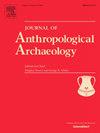Diaspora on the block: Neighborhood archaeology as theory and method
IF 2.2
1区 社会学
Q1 ANTHROPOLOGY
引用次数: 0
Abstract
The archaeology of diaspora has grown in many directions during the first two decades of the 21st century. It has become a key way of understanding the short-term and long-term connections between people and communities defined by movement and migration. However, archaeologists of diaspora still at times struggle with old models of interpretation which seek out ethnic markers in material culture or signs of acculturation. How then do we move past these paradigmatic pitfalls? In this article we look to the concept of the neighborhood as a potential avenue away from a cul-de-sac of theoretical stagnation. Neighborhoods, spatially proximal areas in towns and cities, often comprise multiple diasporic communities in close contact. Ethnic and racial lines are not necessarily neatly maintained, challenging fixity or fluidity binaries when approaching diasporic communities. Thinking of the neighborhood as interpretive model in itself challenges us to think past siloed communities and look to the distinct ways in which social identities and networks are dynamically shaped by living space in urban contexts. Utilizing material from Santa Barbara’s Nihonmachi, we attempt to think through material culture through the lens of the neighborhood, appreciating the blurred lines across the multiple communities living on the block.
街区上的流散:作为理论和方法的邻里考古学
在21世纪的头二十年里,关于侨民的考古学在许多方面都有了发展。它已成为理解由流动和移徙所定义的人与社区之间的短期和长期联系的关键途径。然而,散居的考古学家有时仍在与旧的解释模式作斗争,这些解释模式在物质文化中寻找种族标记或文化适应的迹象。那么,我们如何越过这些典型的陷阱呢?在这篇文章中,我们把邻里的概念看作是一条潜在的大道,远离理论停滞的死胡同。社区,在空间上接近城镇和城市的地区,通常包括多个密切联系的散居社区。民族和种族界限不一定保持整齐,在接近散居社区时挑战固定或流动的二元。将社区本身视为一种解释模式,挑战我们思考过去孤立的社区,并寻找城市环境中生活空间动态塑造社会身份和网络的独特方式。利用圣巴巴拉Nihonmachi的材料,我们试图通过社区的视角来思考物质文化,欣赏生活在街区的多个社区之间模糊的界限。
本文章由计算机程序翻译,如有差异,请以英文原文为准。
求助全文
约1分钟内获得全文
求助全文
来源期刊

Journal of Anthropological Archaeology
Multiple-
CiteScore
4.00
自引率
11.10%
发文量
64
期刊介绍:
An innovative, international publication, the Journal of Anthropological Archaeology is devoted to the development of theory and, in a broad sense, methodology for the systematic and rigorous understanding of the organization, operation, and evolution of human societies. The discipline served by the journal is characterized by its goals and approach, not by geographical or temporal bounds. The data utilized or treated range from the earliest archaeological evidence for the emergence of human culture to historically documented societies and the contemporary observations of the ethnographer, ethnoarchaeologist, sociologist, or geographer. These subjects appear in the journal as examples of cultural organization, operation, and evolution, not as specific historical phenomena.
 求助内容:
求助内容: 应助结果提醒方式:
应助结果提醒方式:


